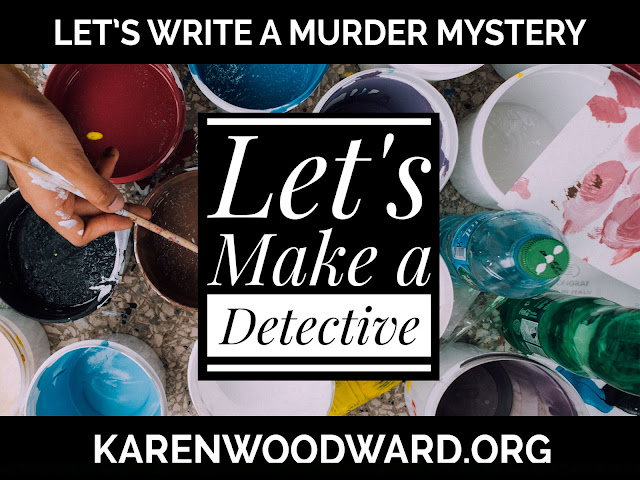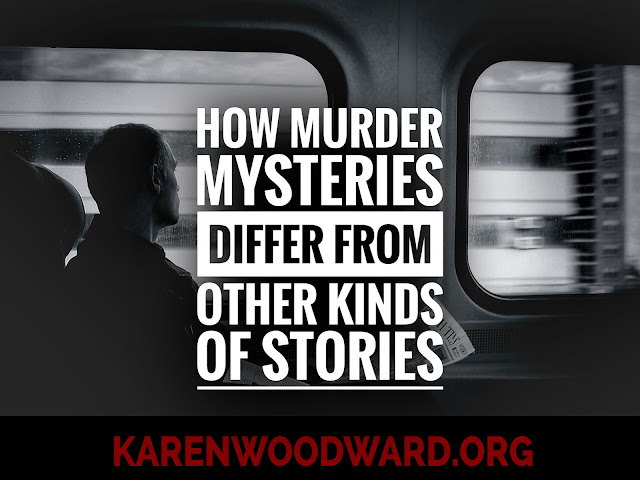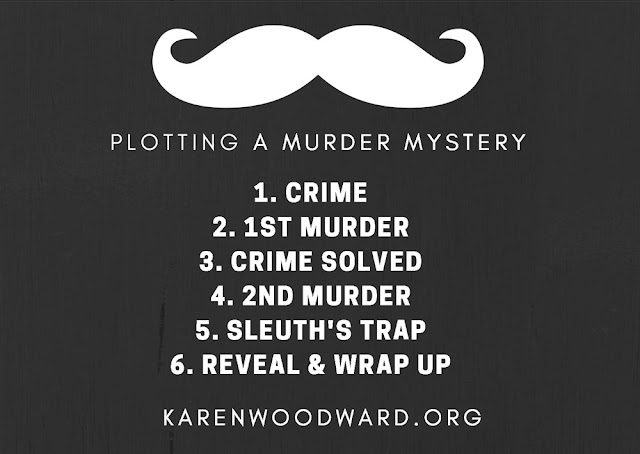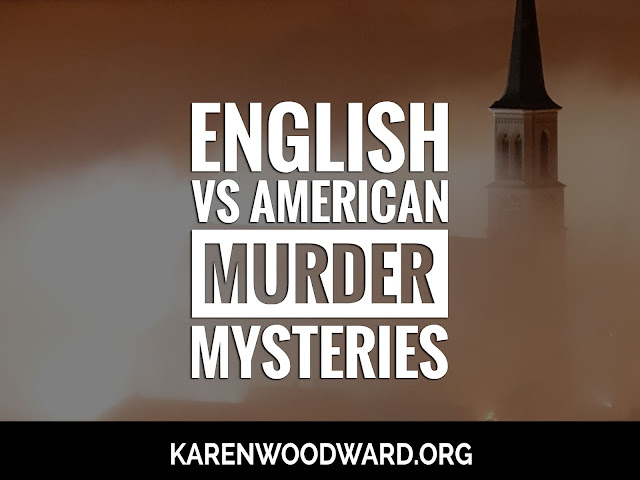Let’s create a detective!
This post is part of my Let’s Write a Murder Mystery! series. In my last post I wrote about the theory behind creating a detective, now it’s time to actually create the character.
Since the detective is SO important to our story, I’m going to split this discussion into two. In this post we’re going to brainstorm and grope our way toward our character. In the next post, we’ll build on the work we do here.
Keep in mind that I don’t have anything planned, no notion of what this detective is going to be like. So, let’s dive in and think about what kind of detective we want to create.
Note: I've included this material in my book: How to Write a Murderously Good Mystery: The Major Characters.
The First Step
The key to creating a realistic character is to rummage about within yourself—your own desires, hopes, fears, motivations and deep dark secrets—to find something you can bestow on your character, something you can infuse into them. It’s a little bit like how, in the Christian New Testament, God breathed the breath of life into Adam and he became a living soul.
Or, to use another analogy, creating a character is like using a starter culture to make yogurt. Yes, I’ve started making my own yogurt! How? By taking a tablespoon of yogurt containing an active culture (I use Activia yogurt), putting it in scalded milk that has been cooled to an appropriate temperature, and leaving the concoction in a warm place for 5 hours. That’s it!
I think something similar needs to happen for a character to come alive. Characters with depth aren’t randomly created, they are CULTURED. They are grown from bits of us, from our memories, dreams, desires, mistakes, goals, failures and successes. They are grown from those bits of our soul we choose to give them.
In what follows, I invite you to look inward. Answer these questions by looking into yourself at different angles, by daydreaming. Let your mind wander.
What is your detective’s name?
Don’t worry if your detective’s name doesn’t come to you right away. I find it’s the LAST thing that comes to me! And I’m not alone.
I talked about exaggeration in my last post. I find the most memorable names are often the most exaggerated.
For example, take the name Aloysius Pendergast. That is NOT a common name. It’s distinctive. As distinctive as the character himself: rail thin with blond-white hair, an accent hailing from the deep south, and charming old world manners.
Of course not all detectives have distinctive names (though Poirot does and, arguably, he’s still the most popular detective ever created!) But it is something to think about.
On a more practical level, google “baby names” and visit one or two of the sites listed. You don’t have to use any of the suggestions but it might spark an idea. Also, if you use Scrivener, you have a name generator. Just go to “Edit > Writing Tools > Name Generator” and there it is!
Start the Culture: Think about your favorite detectives.
Ideas aren’t born in a vacuum. We learn by studying the work of other writers, we learn by studying what has inspired us. So! Let’s study our favorite detectives. We’ll end up throwing various tags and traits into a crucible and (hopefully) transforming them into a detective of our very own.
My favorite detectives are Sherlock Holmes (especially as portrayed by Benedict Cumberbatch), Hercules Poirot and Lieutenant Columbo. What are yours? Try to think of at least two.
Question: Who are your favorite detectives? What especially appeals to you about each? What is EXCITING or memorable about them?
I find it helps to reread the book your favorite detective was first introduced in since this is likely where the author spent a lot of time establishing the character.
In what follows I try to answer these questions for my own favorite detectives:
Sherlock Holmes
In a sense, Sherlock Holmes (and here I’m referring to Benedict Cumberbatch’s interpretation of Sherlock Holmes) is upside down. Whatever normal human reaction you’d expect from him, he gives you the opposite. This is from The Study in Pink:
Watson (to Holmes): A place like this must be expensive.
Holmes: Not really. I know the landlady, Mrs. Hudson. She owes me a favor. A few years back, her husband was sentenced to death in Florida. I was able to help out.
Watson: You stopped her husband from being executed?
Holmes: Oh, no, I ensured it.
This nicely establishes a couple of things. First, that Mrs. Hudson isn’t exactly what she seems, but it does the same for Sherlock. They are definitely characters from the Special World of the Adventure (i.e, inside out and upside down).
What stands out:
- Behavior: odd, quirky, surprising. Holmes says things that subvert one’s expectations.
- Distinctive overcoat (The Belstaff 'Milford' Coat).
- Deerstalker cap.
- Rumpled hair.
- Plays violin.
- Keeps decaying body parts in an otherwise empty fridge.
- Tends to use the walls for target practice.
Hercules Poirot
Poirot isn’t as dramatic as Sherlock, but his reveals ARE exciting. The key to Poirot’s drama, the key to his power, is TRUTH. He knows the truth. Sure, people have tried to deceive him, they may have laughed at him behind his back because of his antiquated clothes and manners, because of his accent, but at the reveal Poirot is King. This is HIS domain. Sure, the suspects tried their little deceptions, but now they are in HIS domain and he demands respect.
Uncovering the truth is Poirot’s superpower. It’s what he does and (in his fictional world) NO ONE is better at it.
What stands out:
- If Poirot had a tagline it would be: I do not approve of murder.
- His accent. How he makes himself seem more foreign to encourage folks to underestimate him.
- Poirot is almost always slightly overdressed.
- Patent leather boots.
- Cane.
- Pince-nez.
- a lapel vase with a boutonniere (a Tussie Mussie or “amphora”).
- Poirot does not appreciate the charms of the country.
- Poirot does not play physically exerting sports.
Columbo
I love it that Columbo appears rumply and unimpressive, unintimidating. In Dead Weight one of the character’s called him an unmade bed.
As a result the murderer usually underestimates him and lets his or her guard down. By the time they realize Columbo is crazy like a fox it’s too late. He’s got all the evidence he needs to arrest them.
What stands out:
- Rumpled beige raincoat.
- Cheap suit.
- Needs coffee in the morning, will drink it in any state even if it’s stale, black and cold.
- Columbo always has to pat down his coat because he can’t find his pen/cigar/match/unpeeled egg. If he can’t find something he will ask those around him until he finds it even if this makes him seem like a lunatic!
- Columbo smokes a very stinky cigar and is often told to put it out or take it away.
- In a few episodes Columbo’s boss says, “I knew you weren’t listening,” when they’re both at a crime scene together.
- Columbo often whistles “This Old Man.”
- Columbo’s car almost always has something wrong with it but the detective thinks it’s the best car ever.
- Flusters suspects by not acting how they expect him to.
- Columbo is fluent in Italian and a good cook.
- Columbo's dog is named "Dog."
I’m curious, which detectives did you pick? What are their three most compelling traits?
Your detective, a first look
Think of your detective. He or she is surrounded by mist. You can’t see them, you can only make out a shape, a silhouette. What does it look like?
Now the mist is clearing, they’re walking toward you. How are they walking? What is their gait like? Is he or she limping? Are they young or old, male or female? Don’t think too hard about it, just see it. What kind of clothes are they wearing? Formal evening wear? Casual wear? Workout clothes? What are they saying? Are they speaking to you? Can you hear their thoughts? Can you feel their emotions?
Write down what you’ve discovered about your character.
(If nothing has come through, I’ve included a character creation exercise at the end of this post.)
I find the process of character creation is different each time. One just needs to keep at it, approach the character from different directions and, eventually, you’ll ‘see’ them, they’ll come to you. As I mentioned, often the key is to put a bit of yourself into the character. Not ALL of yourself, but a part. An aspect. Sometimes this means that your detective will share your gender, sometimes not.
One thing I’m struggling with is whether to make my detective male or female. The outline I’m creating will be for a murder mystery that’s a cross between a traditional detective story with elements of a cozy and, from my experience, those sorts of books generally have a female detective.
On the other hand, all three of my example detectives are male. And, for some reason, it FEELS as though he’s male.
So that’s something! Let’s say that he’s male and in his 30s.
How does your detective dress?
I see him in a black coat, something like what Neo wore in the Matrix but the bottom of the coat is more fitted. He wears jeans. New jeans. They aren't worn or scuffed. And a white shirt or maybe a white t-shirt. Not sure which it is at the moment.
He’s wearing black shoes and black leather gloves.
I’m seeing him how, at least a little bit. It’s a white shirt, not a t-shirt.
I thought he would be more like Columbo, but he’s not. He’s particular about his appearance, especially his hair. It’s collar length and curly. As for color, it’s not black, but VERY deep brown.
What does your detective do for work?
At the moment, I’m not sure how much money my detective makes or what he does for a living. And that’s okay. It’s still early days. But let’s see if I can’t peer into the fog and see my character a bit more clearly.
I want this traditional murder mystery to be a bit like a cozy so perhaps he should own a business.
The rumor is that he used to be a stockbroker (or perhaps a banker) in London but left under mysterious circumstances. It’s difficult to know what his previous life was like, he refuses to talk about it and doesn’t suffer fools gladly.
As for the town, it lies somewhere in upstate New York. Currently, our detective only lives there during the summer months.
I still have no idea what kind of business he runs. During the Winter months he ... I’m not sure. Perhaps he travels. Perhaps he visits a monastery and meditates with the monks.
I think the detective is attracted to the mystical. Perhaps he has been influenced by certain ancient teachings. Perhaps his daily routine (meditations, etc.) have helped him locked the latent powers of his mind (cue Twilight Zone).
What is the detective’s business? Hmm ... Let’s see ... The murderer, Lydia, owns a large beer company that’s on the verge of bankruptcy. We want to contrast the detective and antagonist. I’m not sure it will be HIS business, but I could see him selling amaranth. Just up from where I live there’s a restaurant that specializes in pairing Amaranth with food. I’ve never been, but I love that idea. Amaranth and fine dying. (lol. I meant to write “dining” but it came out “dying”! Perhaps I’ll keep that in the back of my mind as a possible title. Perhaps “Murder and Fine Dying,” “Absinthe and Fine Dying”, “Fine Dying in Meadowmead”? Okay, perhaps not!)
Tentatively, I’ll say the detective owns a restaurant called Absinthe Cafe. The focus is on pairing exotic drinks with delicious food. The food is moderately priced and a good deal for what one gets.
Where does your detective live? What does his lair look like?
Here I’m thinking about Exotic Setting (see the last post).
Now that we know a bit more about the detective, this is easy: he lives above his restaurant! It’s a bit unusual, so that’s good. It’s memorable and it certainly ties in with the character’s occupation!
What’s exotic or unusual about the town? I like the idea of having a festival the town is organized around. For example, in their tip of the hat to Twin Peaks, Psych did a Cinnamon Festival episode.
Cupcake festival! It turns out that cupcakes are the detective’s favorite things in the entire world, a bit like Dean Winchester on Supernatural likes pie. At the moment he is passionate about chocolate cupcakes (the ones with sprinkles on top).
(Or perhaps it’s a chocolate festival. That way I could include interesting, quirky, recipes such as chocolate chili. The detective has a killer chocolate chili cupcake recipe!)
How does the detective’s work and digs add to her memorability?
Gah! I’m writing “her” now. I didn’t mean to. Perhaps I’ll leave the door open to the possibility the detective is female.
In any case, how does the detective's work and accommodations affect his memorability?
I’m drawing a blank. Let’s approach this from another direction. How did Poirot’s apartment help make him memorable?
Order and method. How Poirot ARRANGED things in his apartment said something about his character, about how his mind worked. The modern, geometrical, art on the walls. The art is a prop, it gives Hastings a reason to ask, “Oh! Say that’s new, eh.” He cocks his head to the side, blinks, turns it to the other side. Poirot smiles, comes over, and enthusiastically explains the virtue of the straight lines and the pristine curves.
I think I’m going to hate myself a little bit, but I’m going to make the detective a neat freak. I’m thinking of Monica on the TV show, Friends. I’m going to give him my mother’s favorite expression: A place for everything and everything in its place. This is going to be one of the detective’s more irritating qualities.
I suppose I need to take my own advice and make the detectives predilection for order EXTREME. So—despite what I just said about ‘having a place for everything’—I have to go one of two ways: disorder or order.
Disorder. Columbo has a bit of the existentialist about him. Boundaries are artificial. This helps him escape the ordinary, false, conclusions that other, lesser, detectives settle on.
Order. But that expression, “A place for everything and everything in its place,” FEELS right. The detective is all about bringing order to chaos.
So we’re going for ORDER. That means I need to take the detective's neatness to an extreme, or at least make it memorable.
Now, I’ve said that the detective is attracted to the spiritual, the mystical. But he doesn’t follow any established religion, he has his own take on these things. He does not accept any one tradition whole hog, he picks a bit from this and that and weaves his own story.
So perhaps the order we’re talking about has to do with this mystical order.
“A place for everything and everything in its place” could have a double-meaning. It isn’t merely a matter of arbitrarily finding a place for something. Perhaps this ties into the idea of a memory palace. It isn’t that there is a preordained place for everything, but—given the way he has arranged his memory palace—there is. (Think Hannibal Lector or Pendergast.)
So not only will the detective’s lair tell us about his quirks, his tags and traits, it will tell us about his very MIND, perhaps even his soul (okay, maybe that last part is going a WEE bit over the top, but I’m leaving it in because it’s a little bit true).
That's it for today! In this post we:
- Thought about what the detective's name will be.
- Chose two or three detectives we can use as our own personal examples of what an awesome detective is like.
- Glimpsed the detective for the first time.
- Answered the question: How does your detective dress?
- Figured out what the detective does for work, or—in the case of a cozy—what kind of business he owns.
- Began developing the setting paying special attention to how the detective's work and home add to her memorability.
Next time we'll:
- Finish choosing a name for the detective.
- Develop a tagline.
- Get a start on the detective's character sheet.
- Look at how the detective is connected to the other characters.
- Start developing the the setting, especially the town, the detective's home (his or her lair) and their work.
- Determine the detective's characteristic action.
- Explore the character's strength as well as their weakness.
- Explore the character's psychological wound.
- Explore the character's motivation and goal.
- Continue developing the character's backstory.
- Clarify what the murderer and detective have in common.
- Clarify the characteristics that make your detective awesome, the detective's special talent. What about your character is unique and interesting?
- What is the detective's unique edge on the murderer? What is it about the detective that allows him or her to defeat the murderer at the end of the story?
- What is the detective's hobby?
Update: Link to part 2 of 2: Let’s Make a Detective, Part 2 of 2
Every post I pick something I love and recommend it. This serves two purposes. I want to share what I’ve loved with you, and, if you click the link and buy anything over at Amazon within the next 24 hours, Amazon puts a few cents in my tip jar at no cost to you. So, if you click the link, thank you! If not, that’s okay too. I’m thrilled and honored you’ve visited my blog and read my post.
Today I'm recommending: The Great Courses: Building Great Sentences: Exploring the Writer's Craft. I listen to one of The Great Courses every couple of months or so. The presenters are top notice, the material is revelatory and it's easy to find a format that suits your needs. I prefer listening to audiobooks because it allows me to multitask as I walk to the store or do housework. Try one, you'll like it!
Writing Exercise
Your detective’s tags and traits:
Write down the names of two or three of your favorite fictional detectives. For each detective, write down as many of their tags and traits as you can. Now imagine the detective WITHOUT each of the tags/traits, alone or in combination. When you take away the tag/trait, are they still the same person? This exercise can help you figure out which tags/traits are the most important to the character’s identity.








